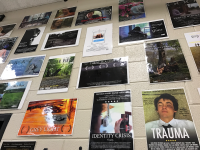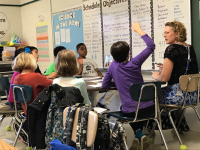Monday
Monday was Columbus Day and that means we spent the day at the kids’ schools. The schools all have open houses that day because many parents have the day off work, plus by that point the kids have been back to school for six weeks, more than half of a marking period, so everyone is or less back in the swing of the routine. We choose to visit Noah’s school in the morning, because that’s when he has his CAP classes and June’s in the afternoon because that’s when she has her only accelerated class (Math 5/6).
At we got out of the car in the high school parking lot, Noah said, “Are you sure you want to do this?” Yes, we did. I’ve always found these visits instructive, ever since the kids were in kindergarten. There’s no substitute for seeing your kids’ classes in action.
Normally Noah has most of his classes every other day, but so parents can see any class there are shortened versions of all nine periods on visitation day. (Doesn’t that make it sound as if the kids are in juvy? Or maybe expecting the Virgin Mary?).
We stayed for four periods—Journalism, Media Production, English, and AP Government. The lesson in Journalism was a discussion about interviewing sources—basically dos and don’ts and the reasons behind them. In Media Production, they were working on their biggest project for the fall—producing trailers for imaginary dystopian films. The teacher talked about the assignment for a while and then they broke into their groups to work on their proposals for the assignment. I occasionally approached his group, and hung around, trying to get close enough to hear but staying far away enough so he didn’t die of mortification. When I wandered away, I admired the posters from last year’s dystopian trailers on the wall.
In both of the next two periods there was a chance we’d see him present something, a speech and a skit, but we didn’t know if his turn would come while we were there, so there was a bit of suspense. The speeches in English were part of their unit on 1984. They had to write a short persuasive speech using ethos, pathos, logos, and at least three propaganda techniques. They’d drawn their topics from two piles of index cards, one of possible audiences and one of proposed actions. This resulted in some amusing combinations. Noah’s favorite was “Convince the RNC to buy tutus.” (Beth said she thought if someone told the RNC Donald Trump would disappear if they’d wear tutus, they’d all be sporting them.)
Noah’s assignment was to convince soccer moms in his school’s PTSA to join his high school’s (imaginary) painting club. We didn’t get to see him give it at school, though we’d both heard it at home—I thought he made especially good use of the slippery slope, by arguing that if moms didn’t spend quality time with their kids this way, the kids would do poorly in school and end up homeless. We did get to hear kids try to convince Santa’s elves to buy English textbooks, nudists to purchase juice with probiotics, single women to adopt cats, and business executives to shave their head to benefit children’s cancers. The kids were smart and funny—they knew how to keep it fun without losing sight of the assignment’s objectives.
In AP Government, the kids were presenting their mock campaign ads. Again, they’d been randomly assigned their candidates and ad formats. Noah’s group was doing what used to be called a “man on the street” ad for Clinton, though Noah said they call it “real people” now. This time we did get to see his group go. I thought Noah had the best line: “I pay my taxes. Hillary Clinton pays her taxes. I mean, that’s something we have in common.” His delivery and timing were just right. Most of the kids chose a skit format, as they hadn’t had much time to prepare their ads, but one group did a video for Johnson, with a student pretending to a little kid talking to his (real) father about the election.
We left Noah’s school around eleven and went to the Sears repair center to drop off our malfunctioning microwave, then out to lunch, and then home for just long enough to do the breakfast dishes and start some laundry and then to June’s school to see her math lesson.
June’s class has been working on multiplying and dividing fractions. The teacher went over a few problems on the Promethean board, covering both the mechanics of different ways to do the problems and also engaging the kids in discussion about why these methods work. Then the students broke into groups to rotate through activities.
June started on a laptop, doing an online review unit on multiplying three-digit numbers by two-digit numbers. Next she played a game with a boy, that involved drawing flat sticks with fraction multiplication problems written on them from a cylinder. They’d take turns solving the problems while other student checked their answers from an answer key. Each time a student correctly solved a problem, he or she would keep it and whoever had more sticks at the end won. The twist was some of the sticks said, “Zap” on them and if you drew that one, you lost all your accumulated sticks. Next June and six other students met with the teacher for small group instruction. The only activity she didn’t get to do was watching videos about multiplying and dividing fractions. The class seemed thoughtfully taught and the kids were engaged.
This was my last Columbus Day observing an elementary school class. Middle school is on the horizon. October is the month fifth graders have to decide if they are applying to any magnets and if so which ones. If June had her way she’d be applying to the performing arts magnet but it’s far away and there’s no bus provided, so we’ve regretfully ruled it out, as we did for Noah.
Of the schools she can apply to, June was adamant for a long time that she only wanted to apply to the humanities magnet Noah attended and not to the math and science one and we’d agreed that was fine. However, when her fourth grade PARCC scores came home last week and her math scores were higher than her reading and writing scores, I said, half-jokingly, “Are you sure you don’t want to apply?”
She surprised me by saying, “I don’t know. Maybe I will.” And later that day, she said she’d decided she would apply to both. I’m glad she’s keeping her options open. If she doesn’t get into either or chooses not to attend one, she’ll go to our home middle school, where she could continue in Spanish immersion. It’s only a quarter of the school day—two periods in Spanish and six in English– but that’s about how her school day breaks down now and it’s another good option to have. I think she could do well at any of those three schools.
Wednesday and Thursday
The kids had Wednesday off school for Yom Kippur and June started working on the application essay for the humanities magnet. As she did so, she spoke somewhat glumly of the odds of getting in (they expect 650 applications for the 100 spots available). “Have some confidence,” Noah said. It was an odd, and touching, moment of role reversal for them.
We’ll be visiting all three middle schools this month, and going to current elementary school to hear a panel of alumni reporting back on each of the schools. The first information session was Thursday evening at the Humanities magnet. They divided the kids and parents up for separate presentations so I’m not sure what she heard, but it must have been very convincing, because when we were re-united she said, “I really want to go here.” We saw a lot of people we knew—I think there were at least five kids from her preschool class alone—not to mention kids she knows from elementary school and extracurricular activities.
It made the idea of June and her peers actually in middle school somewhat less theoretical and abstract. And if we needed any reminder we’re about to leave elementary school behind for good and have two kids in secondary school, this month will be a loud and clear one.


